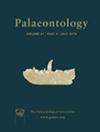三叶虫五个头状附属物的新证据及其对三叶虫头部分节的影响
IF 2.3
2区 地球科学
Q1 PALEONTOLOGY
引用次数: 0
摘要
头节在揭示主要节肢动物类群内部关系方面起着关键作用,但由于背侧三叶虫和腹侧附肢的脱钩,准确确定头节的数量和关系具有挑战性。近几十年来,三叶虫一直被认为有四对头状附属器,通常有五个背节,这已成为了解优足类头进化的基础。根据对保存完好的上奥陶世橄榄石龙(Triarthrus eatoni)和中寒武纪软体龙(Olenoides serratus)软体标本采用的多种分析技术,我们认为在触角的后面还有一对额外的头双附肢,这表明三叶虫有五对头双附肢和六个背侧节。我们建议,考虑到标示触角位置的下穹隆的形态,以及第一睑沟的分叉处融合了两个肌肉附着点,就可以协调 Olenoides 的四条背沟和五条腹侧附肢之间的不匹配。头状双翼附肢的聚合附着点可能会使肢体基部靠近口腔,从而有助于提高捕食能力。本文章由计算机程序翻译,如有差异,请以英文原文为准。
New evidence for five cephalic appendages in trilobites and implications for segmentation of the trilobite head
Head segments play a critical role in revealing the relationships within major arthropod groups but the accurate determination of their number and relationship is challenging because of the decoupling of dorsal tergites and ventral appendages. In recent decades, trilobites have been considered to have four pairs of cephalic appendages and, commonly, five dorsal segments, which has served as the basis for understanding euarthropod cephalic evolution. Based on multiple analytical techniques applied to well‐preserved soft‐bodied specimens of the Upper Ordovician olenid Triarthrus eatoni and middle Cambrian corynexochid Olenoides serratus , we argue that an additional pair of cephalic biramous appendages occurred just behind the antennae, indicating that trilobites had five pairs of cephalic appendages and six dorsally expressed segments. We propose that the mismatch between the four dorsal furrows and five ventral appendages in Olenoides may be reconciled by considering the morphology of the hypostome that marks the position of the antenna and the bifurcation of the first glabellar furrow that has two muscle attachment sites fused. The fusion of clustered attachment sites of the cephalic biramous appendages may have aided feeding ability by gathering the limb bases close to the mouth.
求助全文
通过发布文献求助,成功后即可免费获取论文全文。
去求助
来源期刊

Palaeontology
地学-古生物学
CiteScore
5.60
自引率
3.80%
发文量
43
审稿时长
6 months
期刊介绍:
Palaeontology publishes a wide variety of papers on palaeontological topics covering:
palaeozoology
palaeobotany
systematic studies
palaeoecology
micropalaeontology
palaeobiogeography
functional morphology
stratigraphy
taxonomy
taphonomy
palaeoenvironmental reconstruction
palaeoclimate analysis and biomineralization studies.
 求助内容:
求助内容: 应助结果提醒方式:
应助结果提醒方式:


